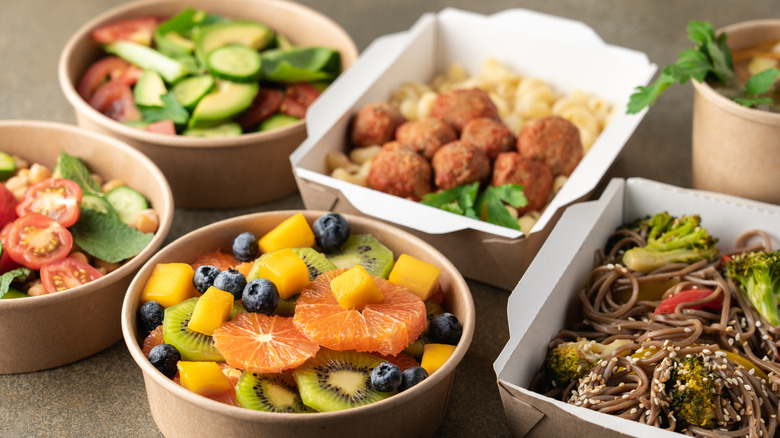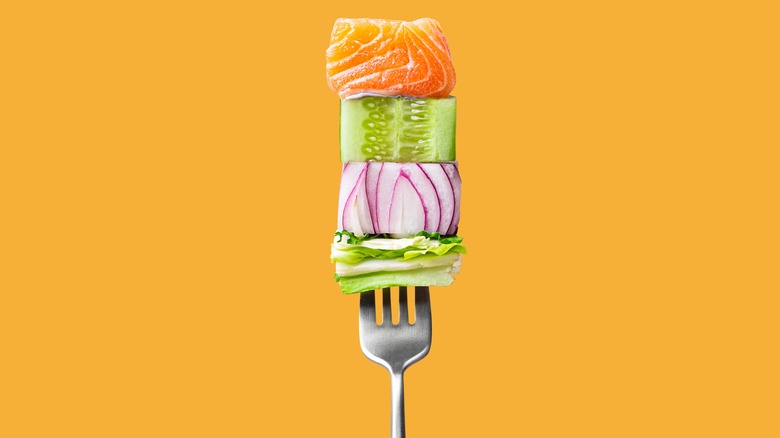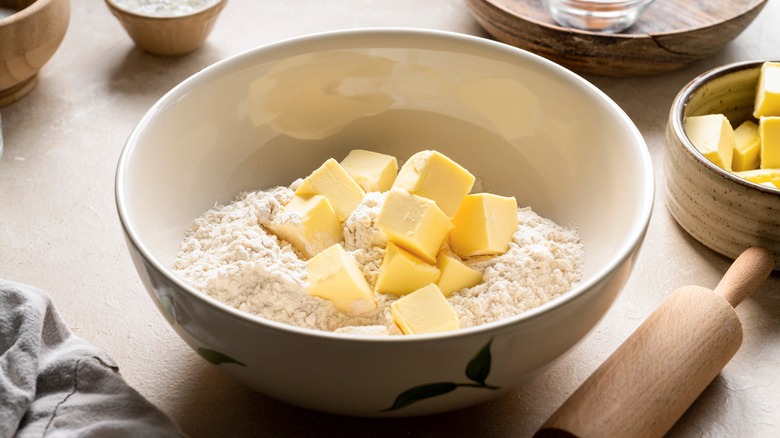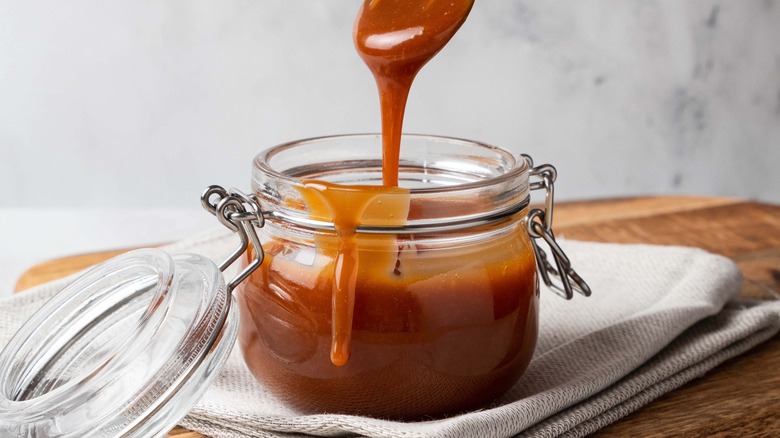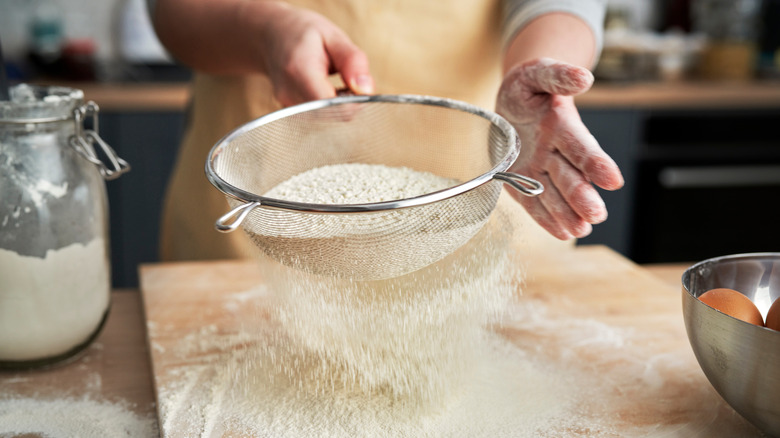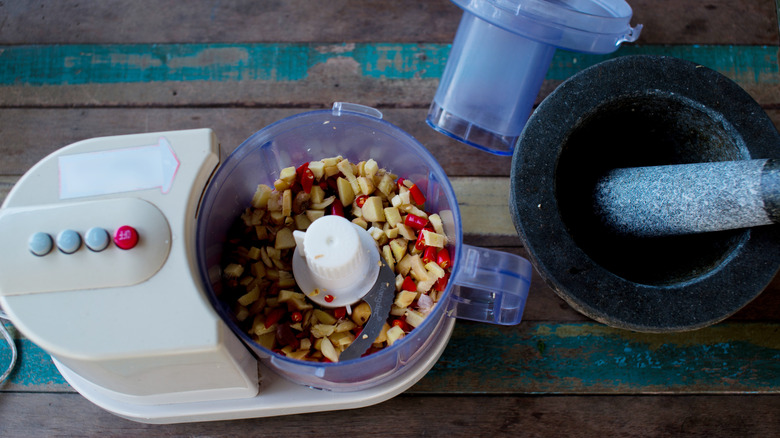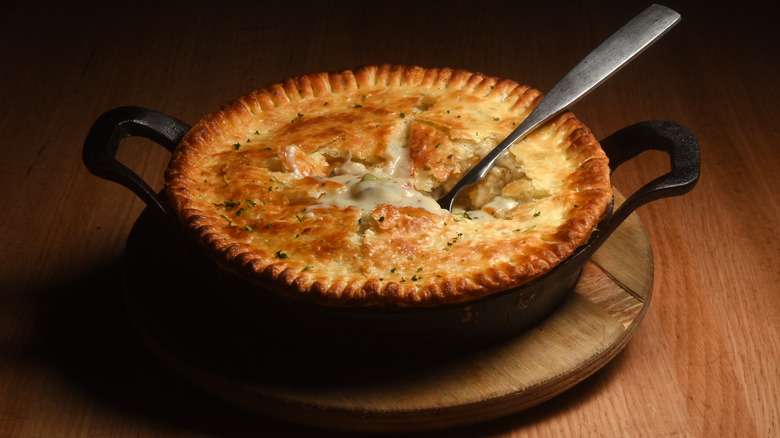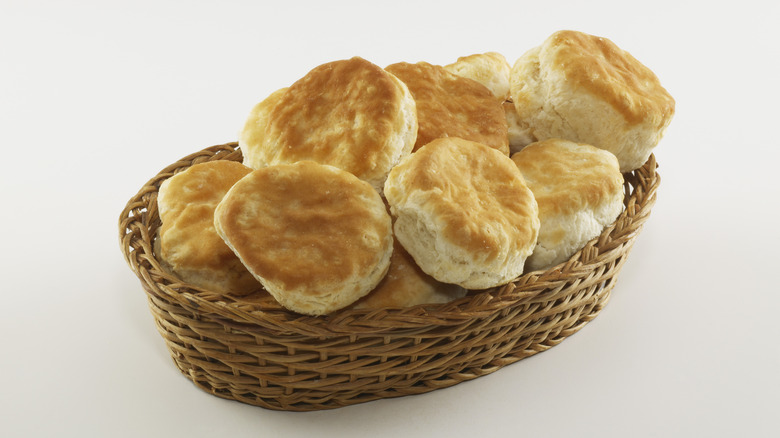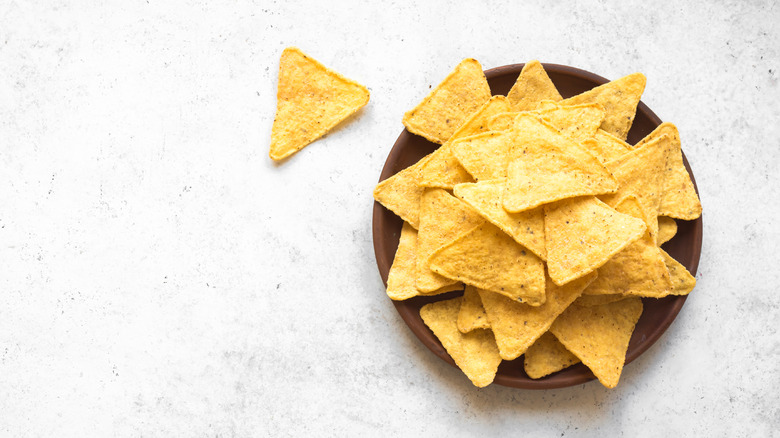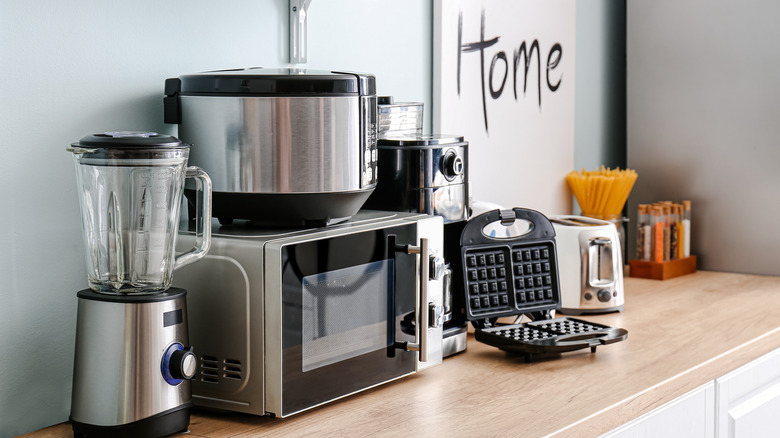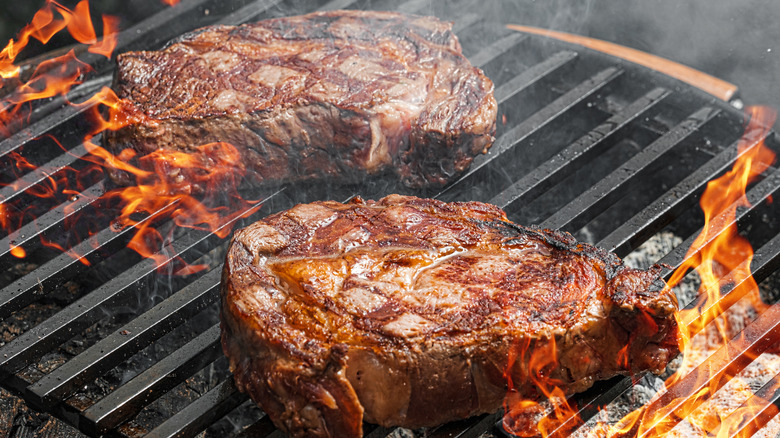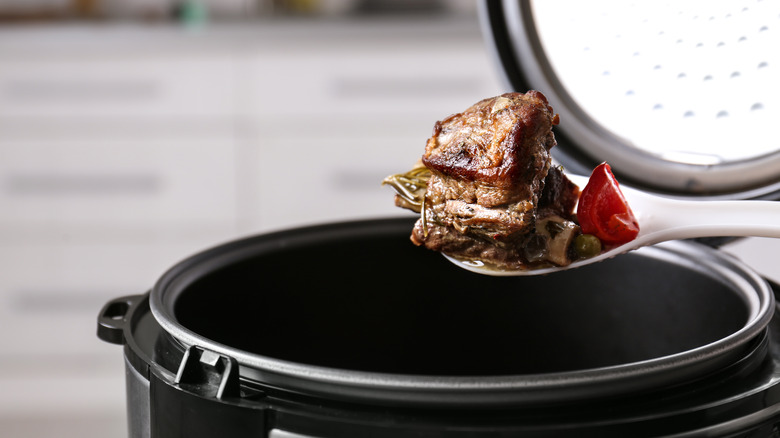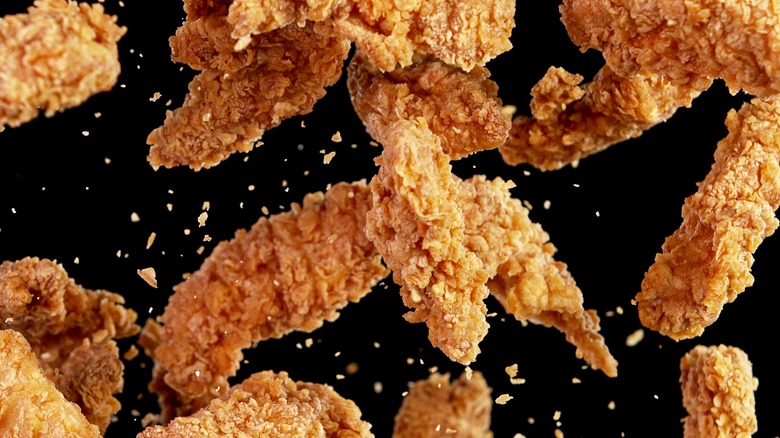Carla Hall's 13 Best Cooking Tips For Home Chefs
Lively, warmhearted, and straight to the point: these are all things that describe celebrity chef Carla Hall. The self-professed culinary late-bloomer has been sharing her no-frills approach to soul food since winning the hearts of many on "Top Chef" in 2008. Her success would be a launchpad into a long and varied food career that covers television, cookbooks, and more. Putting an inventive spin on traditional comfort classics, Hall makes the kitchen an inviting place for aspiring, and seasoned, home chefs alike.
According to Daily Hive, the simple philosophy behind Hall's passion for creating recipes is "making something that people like." This perspective underscores her down-to-earth personality and is one of the untold truths behind her impressive career, especially when it comes to creating food memories for her family to whom she assigns recipes during get-togethers. It also might explain why despite her success, she still doesn't consider herself a celebrity chef.
Humbleness aside, years of training and experience have rewarded Hall with a wealth of culinary knowledge. She uses that insight to keep it real about cooking, encouraging simplicity and substance over style while acknowledging that everyone messes up sometimes. It's just another part of the process. To help you refocus on the essential parts of home cheffing that make it fun and meaningful, we've put together some of Hall's best cooking tips.
Balance health and taste by cooking your own food
Something we all share is a love for tasty food. Yet, there still exists a misconception that healthy food can't be tasty. On one hand, life is short so why not enjoy a guilty pleasure here and there? On another, isn't it amazing when you don't have to sacrifice one for the other? We now know that to be true. This is why there's been a growing shift in how and what we consume.
During a cooking demonstration on OWN, Hall said she believes there's power in knowing how to make your own food, and cooking gives you more control over the ingredients and connects you to the process. You'll naturally consume fewer calories, avoid food allergies, save money, and might, surprisingly, save time, too. Takeout may seem like a way better option after a long day, but, in actuality, there are many recipes that take only 30 minutes to make. You can also cook enough for leftovers, which will save additional time the following day.
Simply put, the long-term benefits of cooking your own food are undeniable. One rule Hall lives by is "cook once, use twice," according to her cooking demonstration, which refers not only to leftovers but also to meal prepping. Even if you only cook three days a week, the difference that meal prepping could make in your body will be totally worth it.
Learn what your personal palate enjoys
Hall says in a "Tamron Hall Show" interview that one of the first, and most important, things every aspiring home chef needs to do is get to know their palate. A simple way of putting it: You need to take the time to learn what you like. In a "Tamron Hall Show" interview, Hall says that new cooks are often scared of foods turning brown and exploring different seasonings.
There's more to learning to cook well than eating and it involves all of the five senses: touch, hearing, sight, and smell, which all impact the taste. Discovering what you enjoy most, versus what you like least, can become your barometer for deliciousness and help you connect with cooking on a deeper level. When you hope to impress, just think about the recipes you really love. In time, we find that a passion for cooking tends to intensify and helps infuse your recipes with love. When you cook for others, guests will also respond with all five of their senses, such as feeling the textures and the sight of carefully plated food building excitement — right after the smell makes mouths water.
Store over-softened butter in your freezer
One of the best flavor enhancers for savory and sweet recipes is butter. From firm to silky smooth, when used right butter is like a conductor; it brings each ingredient into harmony, creating a delicious composition. In the world of baked soul food classics, chef Hall is known for her serious oven skills. From timeless treats like sweet potato pie to southern staples like skillet cornbread, there's no denying her passion for pastries.
Biscuit lovers will fall head over heels after learning her super delicious tip for a flakey crust. A secret to making great biscuits is ensuring that the butter doesn't over-soften from sitting out too long. To avoid this, Hall recommends storing a stick of butter in the freezer while keeping one on your counter. The colder the butter, the flakier the biscuits. A telltale sign that it's gotten too soft is if you can easily squash the butter with your finger. At the true room temperature of 68 degrees Fahrenheit, the butter should bend some but mostly retain its shape. Another way to prevent your golden brick from losing its luster is to roll it around in a dry ingredient like flour until the melty feeling disappears.
Glass lids help keep sugar from crystallizing
Making desserts commonly requires cooking sugar into caramel or syrup. Unless a recipe calls for it, one of the most challenging parts of cooking sugar is avoiding crystallization. When your sugar crystallizes it gives the sauce an undesirable grainy, hard, or thick texture. Crystals form as heated sugar molecules lose moisture while cooling down (via American Chemical Society). Overly stirring your sauce is another surefire way to cause your sugar to crystallize.
Inside Hall's pantry of culinary skills is how to make the perfect sweet and nutty caramel sauce. Of course, she didn't discover how to achieve such saccharine mastery without trial and error. One of the funnest parts of learning something new is that you pick up unique tips along the way. Hall offers a useful tip to make her crave-worthy caramel, and it involves how you store it. While you're cooking the sugar, as it begins to caramelize, Hall recommends using a glass lid for your saucepan. The reason why is that glass allows condensation to form inside the pan, after which, droplets from water build up help the caramel maintain moisture as it's cooking — sometimes it's the smallest of things that make all the difference.
Sift flour before measuring it
Baking can be a tricky bit of business. The slightest measurement shift can impact the end result drastically. Even before measuring, there are important things to keep in mind that could make or break your baking. According to Good Morning America, Hall emphasizes one tip in particular and that's to sift your flour before measuring it. Sifting helps break apart clumps and allows airflow through the flour.
Thanks to modern production techniques, most flour nowadays is pre-sifted. Despite this, for light and airy baking recipes like angel food cake or soft Genoise sponge, it's still recommended you sift even pre-sifted flour. When you don't sift your flour first it settles and becomes inconsistent, leaving you with one or two more tablespoons than necessary. With more flour than the recipe calls for, the dry-to-wet balance will be off when you mix in the instructed amount of liquids.
Make flavored salt with a spice grinder
Keeping it real, salt is perfectly fine as is. It's simply awesome at breathing life into recipes by helping to bring clarity to subtle notes. While you have a choice of iodized salt, sea salt, kosher, and beyond, have you ever tried making your own flavor-infused version? In the same way that salt brings ingredients to life, mixing it with ingredients can elevate it to exciting new levels. The best part is it's quick, easy, and a great gateway to making homemade seasoning blends.
On The Drew Barrymore Show, Hall recommends using an electric spice grinder to amp up the flavor. Many are affordable and, in the long run, will save you a few trips to the spice aisle. Don't be salty if a spice grinder isn't in the budget at the moment, a small hand-crank grinder will work and a coffee grinder does the trick, too. When you're starting out, Hall suggests using ingredients like dehydrated fruits and veggies. Imagine how strawberry-infused salt tastes or lemon zest with aromatic rosemary — the combinations are endless. Thankfully, that's what a kitchen is for, experimenting to your heart's desire.
Crust the top and bottom for flakey chicken pot pie
When you get a recipe right, it tastes delicious from the top to the bottom. While Hall is known for many amazing recipes, the one she's probably most famous for is chicken pot pie. A memorable moment from her time as a contestant on Top Chef is when she was faced with making it for Jimmy Fallon. It was part of a challenge that involved his favorite foods, and as luck would have it, chicken pot pie was also one of Hall's signatures. Hall told Food52 that she associates pot pie with "happy food memories."
The secret to her celebrated chicken pot pie lies in the crust. Before applying an egg wash, Hall suggests creating eight discs of pot pie-sized dough after dividing and rolling it. Then, bake the discs for around 20 minutes. Doing so will help give your dough a flaky texture rather than raw layers, which often happens when you cook the filling and dough together. After you bake the dough, place the discs into a serving dish and add the filling using a spoon. Finally, seal the deliciousness safely and securely by placing a second disc on top. One thing Hall wants you to keep in mind is that following steps doesn't mean you'll get it right on the first go-round. The true secret to flaky pie crust is practice and more practice.
Hand-fold your dough for more airy bread
With quite a few baking tips and tricks up her sleeve, one beloved pastry Hall knows how to make perfectly, are biscuits. In fact, Hall explains in her Flaky Buttermilk Biscuits class that they're one of the first things she attempted to make. Flaky, soft yet sturdy, and buttery moistness are all characteristics of the perfect biscuit. Along with Hall's tip for preventing butter from over-softening, for more airy bread, she suggests hand-folding your dough. The reason why is that it's gentler on the dough, helps remove air pockets that may form as the dough is rising, and will give you a more even consistency.
When your belly is in knead of satisfaction, just follow Hall's five tips for perfect biscuits: The first step is to work with your hands. Rather than a slice, you should use grated cold butter to help distribute it more evenly in the mix. Make sure to use whole buttermilk to give your biscuits a subtle yet pleasing tang. As mentioned, hand-fold and pat your dough, rather than kneading it or using a rolling pin. Lastly, use a biscuit cutter to ensure consistent size and shape.
Use familiar ingredients in different ways
It goes without saying that cooking is an art, which means that there's endless room for creativity and experimentation. Often, our most useful lightbulb moments happen when we're faced with a challenge; As the saying goes: necessity breeds invention. It's inventiveness that gets you out of a culinary pinch, saves time, money, and can even make for a better end result. Hall's favorite recipe for resourcefulness is by taking a familiar ingredient and using it differently. You'll be surprised by what tasty magic you can conjure up in the kitchen.
As an example, Hall put her creative cap on and came up with the idea to use Tostitos in a corn salad. She was inspired by corn and the various ways in which it can be added to a dish. Basically, think about the ingredients you have, what they're made of, their consistency, and any complementary flavor profiles. When you dig a bit deeper, you could discover exciting possibilities that you had previously overlooked. It's a great opportunity to be creative, and stumble across future favorites that you can share with family and friends. As kids, we were told not to play with our food, but when you get older, you learn that playing is one of the most important parts of cooking.
Simplify meal planning by using small appliances
The challenge of cooking for groups is making sure all of the food that hits the table is served hot and ready. With limited oven space, having multiple hot dishes means different prep and cooking times, which often results in ready-to-serve food waiting while other elements finish. This means reheating dishes that have been sitting out, whether in the oven or microwave, right before everything is ready.
Sometimes, we have a tendency to overlook the various ways our appliances can be helpful during the cooking process. Sharing tips on KTNV Channel 13 Las Vegas, Hall recommends that when you're planning a meal to not only think about your stove and oven but use the smaller appliances that you own as well. For example, she says a slow cooker is great for potatoes, and your toaster oven can be used to brown rolls or even for keeping a green bean casserole warm.
Grill meats in advance for summer get-togethers
One of the simple pleasures in life is inviting friends and family over for food and fun. It's an opportunity to catch up, reminisce, and, of course, impress them with new recipes. Cooking for groups does come with challenges though, namely, making sure there's enough food to go around and that guests aren't waiting forever to enjoy a hot plate. Anyone who's shown up to a summer barbeque with an empty stomach in hungry anticipation knows it sucks when the food hasn't even hit the grill yet. Of course, there's a grace period — say maybe 30 minutes to an hour — that drinks and polite banter can fill. Any longer is a buzz kill.
As a seasoned host of get-togethers, Hall knows a thing or two about making guests feel welcome. No doubt she's fired up the grill a bit behind schedule before, but, in an interview with YurView, Hall suggests ways to avoid that: She says some foods can wait until the last minute, like grilled corn, peaches, or romaine lettuce, while others should be cooked prior to folks showing up, like cuts of meat. Burgers fall somewhere between, she explains, meaning you can start them closer to when you expect people to arrive, so they're hot and ready shortly after.
Tenderize cheap cuts of meat with a slow-cooker
Meat is best enjoyed when it's tender and succulent. Unfortunately, with cheaper cuts of meat, you can get lower flavor intensity and tougher consistency. Just because you're on a budget doesn't mean you can't enjoy a quality meat experience. The great thing about cooking is that there's a hack for nearly everything. With a sprinkle of magic cooking dust, you can save money and satisfy your palate. Hall has a great tip for the next time you're making a grocery list but hesitant to include steak on it.
While on Good Morning America, Hall shared 10 tips for getting the most out of a slow cooker, which she says will unlock the delicious tenderness in cheap cuts of meat. As the name suggests, the appliance slowly cooks meats, loosening the stringent connective tissue while retaining the juiciness. The surprisingly versatile kitchen appliances may take a bit more time to prepare a meal, but the end result is totally worth it.
Don't overthink when frying chicken
Some foods fall under the tricky category of being easier to make than they look, while also being more challenging than you think. Fried chicken is one of those foods. It doesn't require many ingredients: chicken legs or breasts, flour, seasoning, and oil. Yet, an under-season here or an over-fry there, and voilà, your chicken can come out of the pan less than desirable. Like anything, it takes practice, but most importantly, Hall believes that you might just be overthinking it.
In an interview with The Daily Beast, Hall recalls how her grandmother made what she considers the best fried chicken, which was simple and straightforward. When she first opened her now-closed restaurant Southern Kitchen, she tells The Daily Beast that she took a more "intellectual" approach, using a brine in an attempt to ensure the meat was thoroughly seasoned. Suffice it to say, the fried chicken didn't taste like her grandmother's.
The chef realized that she was overthinking the recipe. Hall says that she simplified the recipe based on lessons from her childhood: toss the chicken in a seasoning blend, add the blend to the flour, toss the chicken in the flour, let it sit for no more than 15 minutes, then into the frying pan.
Static Media owns and operates Tasting Table and Mashed.

